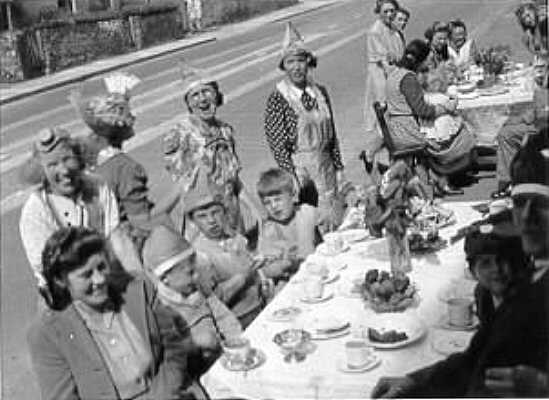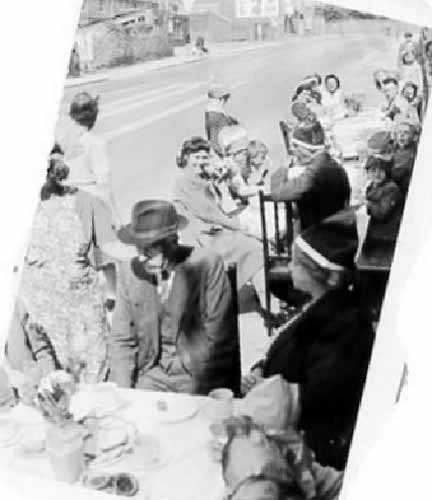Continuing with Bryan Bignell's photographs...
By the way, does anyone remember the Pill boxes and tank barricades which were built by the Rodney Pub to stop the enemy using the main road? As kids we had a lot of fun in them and the home guard often used to do exercises with real guns on weekends. In the following pictures of the street party to celebrate the end of World War II, the anti-tank defence wall by the Lord Rodney pub and the small archway for pedestrians can be seen. They also shows the wall and entrance of Mr Fussells Yard where he kept his horses and carts because he was a haulier.

This end of WWII street party scene shows the houses opposite the Rodney Pub.

Street Party celebrating the end of WWII

Mrs Bessie Hudd (looking at the camera) who lived on the corner of Swan Lane
just above her head is the opening in the wall of Fussells yard
he was a haulier and kept his horses and carts in the yard.
Up a little is the forecourt of the Rodney public house.

Street Party celebrating the end of WWII
In May 2012, I received the following from Paul Plumley, who incidentally also served on HMS Gambia
In the early years of the war Bristol was heavily bombed. The heaviest concentration of air raids was between November 1940 and April 1941. Apart from the casualties, over 81,000 houses were destroyed and many more badly damaged, with over 3,000 later demolished. On 24 November 1941 one of the heaviest raids demolished the mediaeval heart of Bristol and to quote the Lord Mayor, "the city of churches had in one night become the city of ruins".
During this particular air raid I was visiting my grandparents on my father's side. They lived in Bouverie Street, behind the Lawrence Hill bus depot. When the air raids started my father decided that we should try to make it home as my mother was alone. Home being 22 Gordon Avenue, Whitehall. In the beginning, he carried me to the aboveground air raid shelter at the end of the road on Easton Road and when it sounded as if the anti-aircraft gunfire and noise of the bombing and aircraft was diminishing we ran onto the next shelter. At one stage, we sheltered under the railway arch where Easton Road joins the Whitehall Road. Perhaps not the best place to choose, considering that the railway yards were a possible target. Whilst under the arch a soldier joined us and for the uphill run to our home he took turns in carrying me, I was six years old, with my father. Stopping at one more air raid shelter in the playground of a primary school at the end of Chalks Road, St George. We joined my mother in the Anderson shelter at the bottom of the garden. I was to spend quite a few nights in the shelter. That wasn't to be the only night we listened to the rattle of the shrapnel from the anti-aircraft guns falling to the road. Our closest big gun was known as "Purdown Percy"
In common with all the small boys I knew, we spent the mornings after, scouring the streets to see who could pick up the biggest piece of shrapnel .This was the beginning of the story of my evacuation. It lasted for almost five years, until I returned home after my eleventh birthday.
In January 2017, Paul wrote to me again concerning his wartime experiences and evacuation.
This page created April 25, 2010; last modified January 25, 2022



